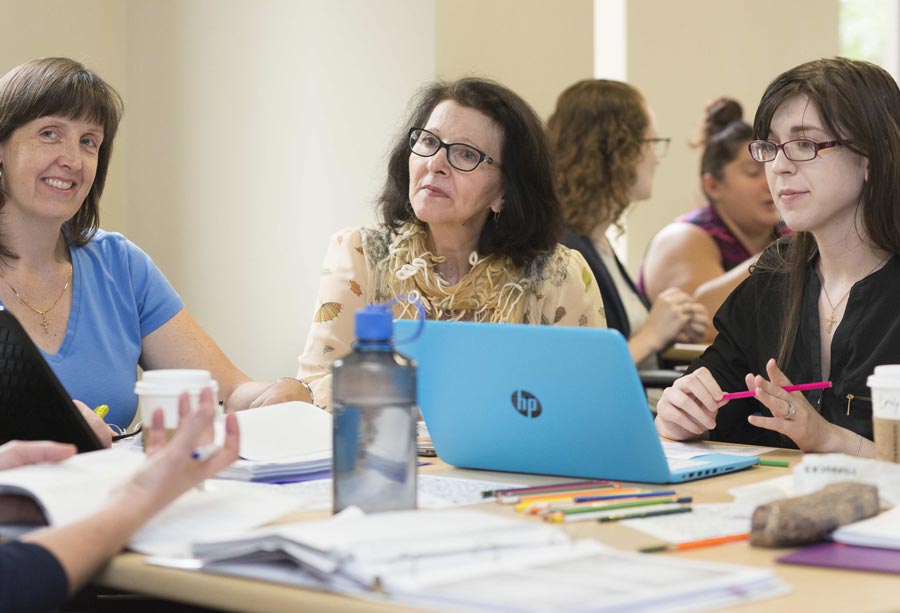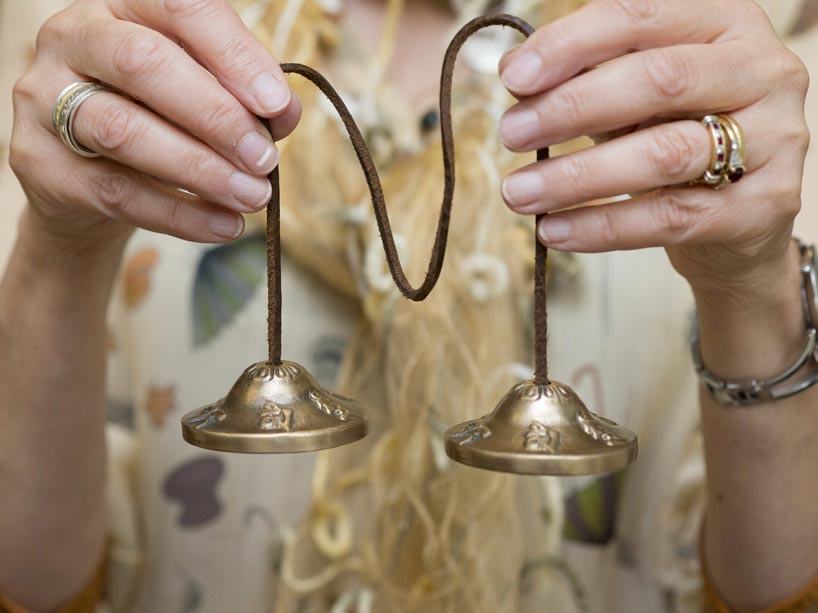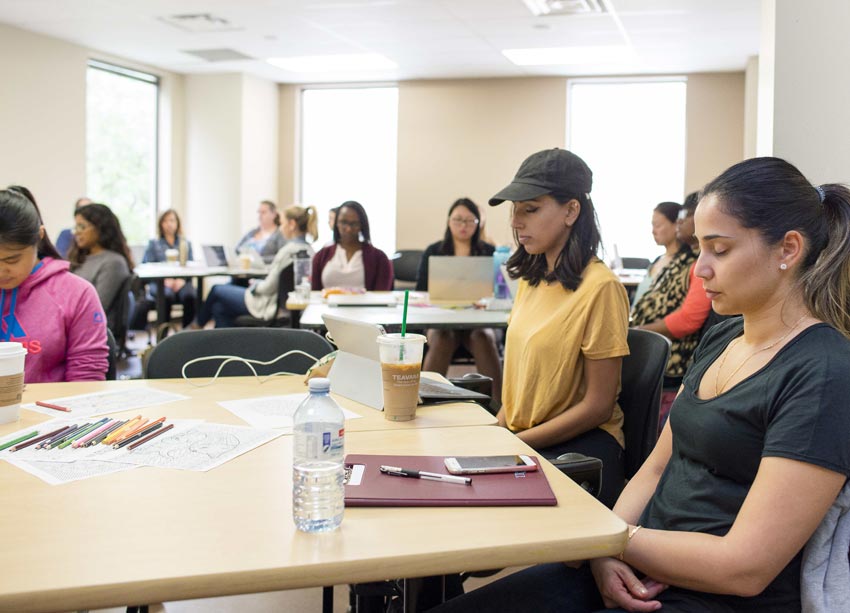Mindfulness in the classroom
Photos: Nursing professor Jasna Schwind, centre, says imagination and creative self-expression play key roles in learning and clinical practice; Mindfulness bells mark the beginning and end of brief mindful breathing practice; and nursing students practise meditation. Their feedback demonstrates the benefits of creative exercises and relaxation techniques in the classroom. All photos by Ryan Enn Hughes.
It's a warm Thursday afternoon and nursing professor Jasna Schwind's graduate class on knowledge development in nursing is set to begin. In many ways, the classroom is like any other at Ryerson University: students are opening their notebooks, typing on laptops and sipping from large plastic cups of iced coffee.
On the tables, however, are some unexpected items: pencil crayons and black-and-white mandalas, intricate symbols of the universe. A staple of adult colouring books, a casual form of art therapy for grown-ups seeking relaxation, the mandala designs are here because, in Schwind's class, colouring isn't just permitted, it's encouraged. As are other creative pursuits, such as storytelling.
"Nurses are always dealing with people, who sometimes may be in life-critical situations. They need safe tools to help them reflect on their personal and professional experiences and to connect with people in their care," says Schwind. "Creative self-expression helps us access ideas and understanding in our unconscious that have not yet coalesced into words. We know more than we can say."
Schwind uses several innovative approaches in her classrooms to deepen students' learning, strengthen their self-knowledge as future caregivers, reduce their stress and anxiety and improve their overall well-being. Her efforts haven't gone unnoticed; during the 2017-18 academic year, she received a Faculty of Community Services' Dean's Teaching Award. Her other honours include the Ryerson Provost's Experiential Teaching Award, the Teaching Innovation Award from the Council of Ontario University Programs in Nursing and the Gail J. Donner Award for Excellence in Nursing Education from Toronto’s Lambda Pi-At-Large chapter of the Sigma Theta Tau International Honor Society of Nursing.
Schwind's classes are bookended by brief, stress-reducing activities: to open the session, a few minutes of mindful breathing ("So we all arrive and are present to engage in our work together," says Schwind) and at the close, a loving-kindness meditation that cultivates compassion for oneself and others. In between, students are encouraged to colour mandalas while listening and participating in the class discussion.
Students also work in self-selected and self-governed Teaching-Learning Groups (TLG). The groups enable students with shared course topic interests to discuss and prepare for their group-facilitation assignment. Throughout the term, the TLG members divide the assigned readings and summarize the content for each other, so they can all come prepared for class discussions.
The activities have made a difference for students. For example, in end-of-course assessments of Schwind's teaching, students have consistently reported the benefits of the creative exercises and relaxation techniques, and have requested that they be integrated in all courses. A number of students have also reported that colouring mandalas has increased their classroom engagement and decreased their desire to check their phones and social media.
The impact isn't just anecdotal, though. Schwind's own research has shown that the imagination and creative self-expression play a key role in learning and clinical practice. In one project, Schwind explored how art can help students and nurses in mental health and in the classroom express complex ideas. The study, which also involved nursing professor Gail Lindsay of the University of Ontario Institute of Technology, was published in the International Practice Development Journal in 2015.
The participants in that study, and others, produced stories and various forms of art and music to increase their self-awareness. For example, they were asked to choose a metaphor that best represents them as “instruments-of-care” -- Schwind’s metaphor for their respective professional roles -- and then to draw it and have the selected metaphor, such as an elephant or sponge, write them a letter back. Doing so enabled the participants to expand their capacity for personal reflection and to consider how their newly accessed personal knowing could help them bring forward their authentic self and make connections with people in their care.
"My goal is to help students be their authentic selves and to learn who they are as instruments of care," says Schwind, "and to show them how they can build and nurture relationships with themselves and with others, regardless of the context."
Schwind has also explored mindfulness practice as a teaching-learning strategy in higher education and is now undertaking a follow-up study to help professors use mindfulness in their teaching. Those projects involve Ryerson nursing faculty Elizabeth McCay, Heather Beanlands and Lori Schindel Martin, and child and youth care professor Jennifer Martin and early childhood studies professor Marni Binder.
Award nominations for university employees are now open. Nominate an employee who demonstrates excellence in the areas of service and leadership; scholarly, research and creative activity; and teaching and education. Visit the Recognition and Awards website for more details and to nominate a deserving employee.


